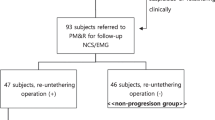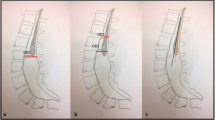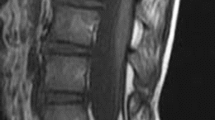Abstract
Object
An increasing number of asymptomatic children are diagnosed with occult spinal dysraphism, raising the question of their optimal management. Urodynamic study (UDS) is the most reliable method of detecting neuro-urological abnormalities in these children. The rate of postoperative retethering ranges from 10 to 20% and is not always immediately clinically significant. The aim of this prospective study was to develop a reliable method that could be used in the preoperative assessment and postoperative follow-up of children with a tethered cord syndrome (TCS).
Methods
From 1989 to 1997, 15 children underwent spinal cord untethering for TCS. Preoperatively, patients were assessed with MRI and UDS. Postoperative UDS were repeated at 6- to 12-month intervals. Four UDS parameters were identified, graded, and added to obtain a UDS score. A group of 38 children without dysraphic condition was used as control and allowed the calculation of a normal score.
Conclusions
There was a statistically significant difference in the preoperative UDS scores between the control group and the study group (p<0.001). Postoperatively, there was a statistically significant improvement (p<0.001) in UDS scores. UDS score is a reliable tool for identifying and quantifying neuro-urological disorders in patients with TCS. Postoperatively, this score was useful in the early diagnosis of spinal cord retethering.


Similar content being viewed by others
References
Bauer SB (1992) Neuropathy of the lower urinary tract. In: Kelalis PP, King LR, Belman AB (eds) Clinical pediatric urology. Saunders, Philadelphia, pp 399–440
Brading AF, Turner WH (1994) The unstable bladder: towards a common mechanism. Br J Urol 73:3–8
Chancellor MB, Kaplan SA, Blaivas JG (1990) Detrusor-external sphincter dyssynergia. Ciba Found Symp 151:195–213
Colak A, Pollack IF, Albright AL (1998) Recurrent tethering: a common long-term problem after lipomyelomeningocele repair. Pediatr Neurosurg 29:184–190
DiPietro MA, Venes JL (1988) Real-time sonography of the pediatric spinal cord: horizons and limits. Concepts in pediatric neurosurgery, vol 8. Karger, Basel, pp 120–132
Foster LS, Kogan BA, Cogen PH, Edwards MS (1990) Bladder function in patients with lipomyelomeningocele. J Urol 143:984–986
Galloway NT, Mekras JA, Helms M, Webster GD (1991) An objective score to predict upper tract deterioration in myelodysplasia. J Urol 145:535–537
Garceau GJ (1953) The filum terminale syndrome (the cord traction syndrome). J Bone Joint Surg Am 35:711–716
Gross AJ, Michael T, Godeman F, Weigel K, Huland H (1993) Urological findings in patients with neurosurgically treated tethered spinal cord. J Urol 149:1510–1511
Hellstrom WJG, Edwards MSB, Kogan BA (1986) Urological aspects of the tethered cord syndrome. J Urol 135:317–320
Hjalmas K (1988) Urodynamics in normal infants and children. Scand J Urol Nephrol 114 [Suppl]:20–27
Houle AM, Gilmour RF, Churchill BM, Gaumond M, Bissonnette B (1993) What volume can a child normally store in the bladder at a safe pressure? J Urol 149:561–564
Houser EE, Bartholomew TH, Cookson MS, Marlin AE, Little NA (1994) A prospective evaluation of leak point pressure, bladder compliance and clinical status in myelodysplasia patients with tethered spinal cords. J Urol 51:177–181
Johnson DL, Levy LM (1995) Predicting outcome in the tethered cord syndrome: a study of cord motion. Pediatr Neurosurg 22:115–119
Kaplan SA, Chancellor MB, Blaivas JG (1991) Bladder and sphincter behaviour in patients with spinal cord lesions. J Urol 146:113–117
Keating MA, Rink RC, Bauer SB, Karup C, Dyro FM, Winston KR, Shillito J, Fischer EG, Retik AB (1988) Neurourological implications of the changing approach in management of occult spinal lesions. J Urol 140:1299–1301
Khoury AE, Hendrick EB, McLorie GA, Kulkarni A, Churchill BM (1990) Occult spinal dysraphism: clinical and urodynamic outcome after division of the filum terminale. J Urol 144:426–429
Kondo A, Kato K, Kanai S, Sakakibara T (1986) Bladder dysfunction secondary to tethered cord syndrome in adults: is it curable? J Urol 135:313–316
Norgaard JP, Van Gool JD, Hjalmas, Djurhuus JC, Hellstrom AL (1998) Standardization and definitions in lower urinary tract dysfunction in children. Br J Urol 81 [Suppl 3]:1–16
O’Neill P, Stack JP (1990–1991) Magnetic resonance imaging in the pre-operative assessment of closed spinal dysraphism in children. Pediatr Neurosurg 16:240–246
Palmer LS, Richards I, Kaplan WE (1998) Subclinical changes in bladder function in children presenting with non urological symptoms of the tethered cord syndrome. J Urol 159:231–234
Pierre-Kahn A, Zerah M, Renier D, Cinalli G, Sainte-Rose C, Lellouch-Tubiana A, Brunelle F, Le Merrer M, Giudicelli Y, Pichon J, Kleinknecht B, Nataf F (1997) Congenital lumbosacral lipomas. Childs Nerv Syst 13:298–334
Roy MW, Gilmore R, Walsh JW (1986) Evaluation of children and young adults with tethered spinal cord syndrome. Utility of spinal and scalp recorded somatosensory evoked potentials. Surg Neurol 26:241–248
Tani S, Yamada S, Knighton RS (1987) Extensibility of the lumbar and sacral cord. Pathophysiology of the tethered spinal cord in cats. J Neurosurg 66:116–123
Van Gool JD, Dick P, de Jong TP (2001) Bladder-sphincter dysfunction in myelomeningocele. Eur J Pediatr 160:414–420
Vernet O, Farmer JP, Houle AM, Montes JL (1996) Impact of urodynamic studies on the surgical management of spinal cord tethering. J Neurosurg 85:555–559
Vernet O, O’Gorman AM, Farmer JP, McPhillips M, Montes JM (1996) Use of the prone position in the MRI evaluation of spinal cord retethering. Pediatr Neurosurg 25:286–294
Yamada S, Zinke DE, Sanders D (1981) Pathophysiology of “tethered cord syndrome”. J Neurosurg 54:494–503
Yip CM, Leach GE, Rosenfeld DS, Zimmen P, Raz S (1985) Delayed diagnosis of voiding dysfunction: occult spinal dysraphism. J Urol 134:694–697
Author information
Authors and Affiliations
Corresponding author
Rights and permissions
About this article
Cite this article
Meyrat, B.J., Tercier, S., Lutz, N. et al. Introduction of a urodynamic score to detect pre- and postoperative neurological deficits in children with a primary tethered cord. Childs Nerv Syst 19, 716–721 (2003). https://doi.org/10.1007/s00381-003-0829-7
Received:
Published:
Issue Date:
DOI: https://doi.org/10.1007/s00381-003-0829-7




